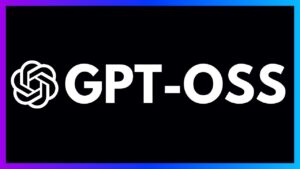OpenAI’s Bold Move: GPT‑OSS Launch. On August 5, 2025, OpenAI officially unveiled GPT‑OSS, marking its first release of open‑weight models since GPT‑2 in 2019. The release includes two models:
- gpt-oss‑120b (≈ 117–120B parameters)
- gpt-oss‑20b (≈ 20–21B parameters)
Unlike open‑source models, open‑weight means the trained parameter files are released under the Apache 2.0 license—without the original training code or data—empowering developers to fine‑tune, inspect, or self‑host the models.
CEO Sam Altman called it “the best and most usable open model in the world,” competing directly with offerings from Meta (LLaMA), DeepSeek, and others.
Performance & Capabilities
- Reasoning & Coding: GPT‑OSS models match or outperform OpenAI’s proprietary o3‑mini and o4‑mini across reasoning, agentic workflows, mathematics, and coding tasks.
- Chain‑of‑Thought support and Structured Outputs enable transparent reasoning paths when used in workflows.
- Adjustable reasoning effort: Users can configure low/medium/high reasoning modes depending on tasks, latency, or compute budget.
- Tool use and agent support: Compatible with OpenAI’s tool‑calling APIs, allowing model actions like web search or code execution.
Architecture and Efficiency: MoE × MXFP4
GPT‑OSS models use a Mixture‑of‑Experts (MoE) architecture with selective activation of experts per token and 4‑bit quantization (MXFP4)—crucial for reducing memory demands while keeping inference fast.
- gpt‑oss‑20b: Only ~3.6B active parameters at inference.
- gpt‑oss‑120b: ~5.1B active parameters—makes it feasible on GPU systems like H100 or RTX 6000 series.
This design enables running the 20B variant on consumer hardware (≥16 GB RAM), and the larger 120B version on high‑end single or multi‑GPU servers (≥60–80 GB VRAM).
Running Locally: Tools & Deployment Paths
OpenAI has worked with many ecosystem partners to ensure smooth deployment across platforms.
Ollama (Terminal interface)
- Supports both model sizes
- Minimal setup:
ollama pull gpt-oss:20bandollama run gpt-oss:20b
LM Studio (Desktop GUI)
- Supports drag‑and‑drop chat UI, reasoning effort adjustment, and OpenAI‑style API serving.
Hugging Face Transformers
- Pipeline-based prototypes or advanced multi-GPU servable deployments
- Supports
transformers serve,openai-harmony, LangChain, LlamaIndex, and streaming endpoints.
☁️ Cloud Deployment: AWS, Azure, etc.
- Available via Amazon SageMaker JumpStart, with managed deployment on GPU instances like
p5.48xlarge, network isolation support, and integration with EXA web-search tool. - Azure AI Foundry/Windows AI Foundry also provides environments for edge to enterprise use with secure local inferencing.
- Most cloud vendors partner (Hugging Face, Databricks, TogetherAI, Baseten, Fireworks, Vercel) for seamless access.
Safety & Competition
OpenAI delayed the GPT‑OSS release twice to conduct external safety audits, simulate misuse (e.g. biotech weaponization), and triangulate expert assessments. The models were found to be safe under their internal testing procedures.
The launch is partly framed as a response to DeepSeek’s R1, released in January 2025 and gaining traction globally. OpenAI positions GPT‑OSS as a democratic, U.S.-based open stack that counters foreign open-source dominance.
Community Reaction
Early Reddit discussions reflect cautious optimism:
“I believe it when I see it. OpenAI claim… going to be best”
“Even the 117B seems to fit into my laptop” (referring to 120B)
Benchmarks are only starting to appear, but users expect GPT‑OSS to rival or exceed existing open models like Qwen 30B or DeepSeek’s offerings.
Summary Table: GPT‑OSS Overview
| Model | Parameters | Active Params | Hardware Needs | Comparable Closed Model |
|---|---|---|---|---|
| gpt‑oss‑20b | ~21B | ~3.6B | ≥16 GB VRAM (consumer) | o3‑mini |
| gpt‑oss‑120b | ~117–120B | ~5.1B | ≥60–80 GB GPU memory (e.g. H100, multi‑A100 split) | o4‑mini |
Why GPT‑OSS Matters
- Democratization of AI
Open‑weight access under Apache 2.0 empowers innovators at all scales—no rate limits, no cloud lock‑in. - Privacy & Offline Use
Run fully offline without dependency on external APIs. Ideal for sensitive use-cases. - Customization
Fine‑tune, tweak reasoning settings, or embed within apps. Full chain‑of‑thought transparency makes accountability easier. - Ecosystem Support
Broad support via Hugging Face, Ollama, LM Studio, cloud partners etc.—simplifying adoption and scaling. - Competing with China & Meta
Strategic positioning against DeepSeek’s R1, LLaMA variants, and other open models—reasserting U.S. leadership.
Getting Started: A Quick Guide
- Choose model size:
- Small:
gpt‑oss‑20bfor laptops or <=16 GB VRAM setups - Large:
gpt‑oss‑120bfor high‑memory GPU servers
- Small:
- Select your platform:
- Ollama: easiest terminal-based local experience.
- LM Studio: GUI with built-in API compatibility.
- Transformers: full control for developers or researchers.
- AWS / Azure / SageMaker / Foundry: scalable enterprise-grade deployments.
- Install & launch:
- Ollama:
ollama pull gpt-oss:20b→ollama run gpt-oss:20b - Transformers:
transformerslibrary,device_map="auto", optionallytransformers serve.
- Ollama:
- Fine‑tune or customize (if desired):
- Use Hugging Face Trainer / Accelerate for fine-tuning workloads.
- Or adjust prompt templates / cost controls for efficient deployments.
- Integrate and iterate:
- Build agents (with Strands Agents SDK)
- Combine with tool-uses (web search, code execution, plugins)
- Scale via SageMaker or Azure Agent systems.
OpenAI’s Bold Move: GPT‑OSS Launch
OpenAI’s GPT‑OSS represents a significant pivot toward openness and accessibility in high‑performance LLMs. With dual model sizes optimized for consumer and enterprise hardware, an Apache 2.0 license, broad ecosystem compatibility, and strong reasoning capabilities, GPT‑OSS breaks new ground for self-hostable, modifiable, and scalable AI infrastructure.
Whether you’re a developer building a local chatbot, a researcher conducting reasoning experiments, or an enterprise embedding AI agents in-sensitive environments, GPT‑OSS offers the transparency, flexibility, and performance needed to push forward with confidence. OpenAI’s Bold Move: GPT‑OSS Launch.

